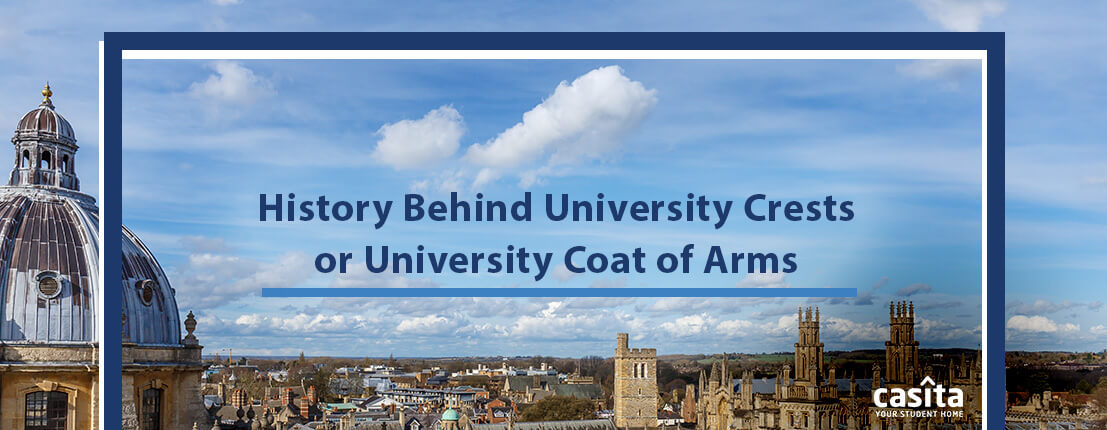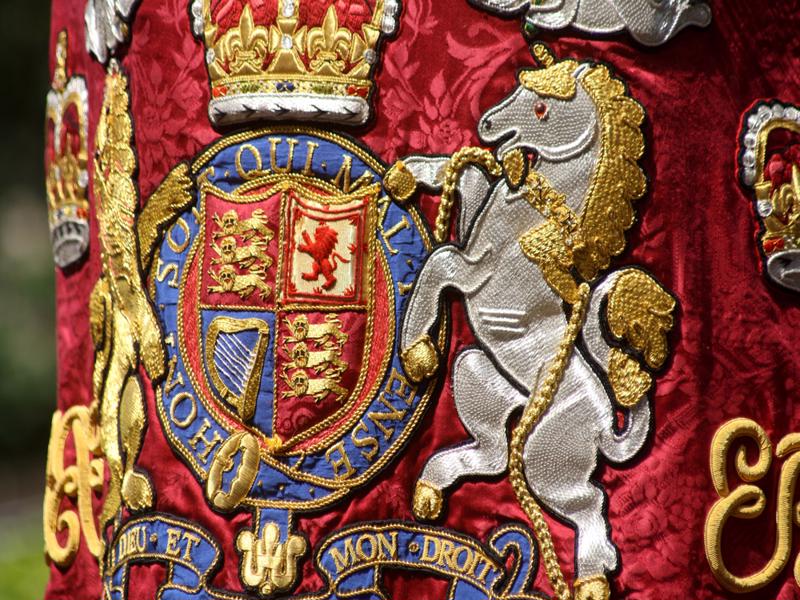History Behind University Crests or University Coat of Arms
Exploring
4 mins read
Share

Updated at: 16 December, 2024
Published at: 13 September, 2019
By Noura Yousef
History Behind University Crests or University Coat of Arms
Exploring
4 mins read

Updated at: 16 December, 2024
Published at: 13 September, 2019
By Noura Yousef
Share
What Is a Coat of Arms?
It’s a unique design on a shield of a medieval knight. It is usually a representative of the achievement of the person, state, university or corporation to whom it was granted.
The coat of arms usually consists of four components:
1. The Motto: It is the motto of the person, corporation or university that owns the arm. It can be a preferred quote or just a sentence that the organisation feels represents them. The motto is sometimes not placed in the design; however, when present, it is usually located at the top of the arms.
2. The Crest: A three-dimensional symbol that identifies the achievements of the owner of the arms. It is usually located right under the motto in the design.
3. The Shield: Since the coat of arms was originally painted on a real shield, it is an original part of the design now. The shield usually has different designs painted on it, and their placement and colours tell a story about the origin of the arms. The design on the shield is a representative image of what the arms would have looked like if the granted person or entity ever took to battle.
4. Supporters: They are usually two people or animals standing on both sides of the shield. They also often tell a part of the story of the origin of the arms.
Coat of Arms History
The origins of the coat of arms date back to the 11th century AD. Within the drawings on the Bayeux Tapestry; some knights are seen holding shields with heraldic crests on them. The crests were drawn as simple crosses back then. However, that is the first-ever recorded existence of the coat of arms.
Later during the 12th century, The usage of the coat of arms increased, feudal lords and knights used the arms in battle, and it started to become an honour to have a coat of arms in the family.
University Coat of Arms
As the popularity of the coat of arms increased, the scope of its representation increased as well. The coat of arms evolved from a personal grant by the king to an award that is given to a family, an organisation or a university.
The College of Arms in the UK is the entity responsible for providing this grant to any person or organisation. Universities that receive a coat of arms consider it a perfect representation for their core values and treasured links to the past. The people responsible for granting the coat of arms are usually called Kings of Arms.
Which UK Universities Have Coat of Arms?
For a university to get a coat of arms, it must be a well-established educational institution with a respected history in its field. It must also have a good and stable financial standing. The following universities have managed to get a coat of arms specially designed to represent them.

Coat of Arms of the University of Cambridge
The university has more than 800 years of history, so there’s no wonder it has a coat of arms. It is known for being the home of famous thinkers, like Stephen Hawkings, Charles Darwin and Richard Stone. The university was granted its coat of arms at the 1573 visitation by the king of arms, Robert Cooke, a graduate of St John's College.
The Motto: There is no Motto in this design; however, the underlying message of the university can easily be guessed from the drawings.
The Crest: Cambridge University, like some other older corporate bodies, has no crest, the full drawings can be seen on the shield only.
The Shield: The shield is the main part of this coat of arms, and it comes with a drawing of four gold lions facing the left side of the shield and an ermine cross drawn in the centre. In the middle of the cross, there is a closed book with a clasp and decorated edges. The lions represent the university's royal patronage, the ermine symbolises dignity, and the book is the Bible, and it describes the knowledge and the Christian faith of the university.
Supporters: They were not a part of the main coat of arms during the time Cambridge received its coat of arms; therefore, there are no supporters in this design.
.jpg)
Oxford University Coat of Arms
Oxford University was granted its coat of arms in 1400. It went through various changes throughout the years to reach its current design.
The Motto: Written on an open book in the middle of the arms, you can read the words "DOMINVS ILLVMINATIO MEA" meaning "The Lord is my light".
The Crest: There is no crest in this unique design.
The Shield: The shield has the motto, the open book, and three crowns, two on top of the book and one below it. The origin of the three crowns is not known. However, a famous theory suggests that they represent King Edmund the Martyr, King Arthur, and Jesus Christ.
Supporters: Like many other old institutions, there are no supporters in this design.
.jpg)
The University of Sussex Coat of Arms
The coat of arms and the crest of the University of Sussex were granted to it in 1962. The coat of arms had then developed to include supporters as the main part of its design.
The Motto: “Be Still and Know” is the motto you can easily read on this university coat of arms. It is representative of the amount of knowledge you get at the university.
The Crest: The Helmet and the Dolphins on top of the shield represent the crest of this university. The dolphin is said to be borrowed from the arms of Brighton.
The Shield: The shield has a drawing of six martlets, a dolphin and two crowns. The six martlets are taken from the arms of East Sussex and West Sussex, and the dolphin represents Brighton.
Supporters: The supporters of this particular coat of arms are two pelicans standing on closed books and carrying two flags. The books represent knowledge, and the drawings on the two flags represent the Cinque Ports Lion and Ship symbol for Hastings in Sussex.
Exploring
By Noura Yousef
Share
Exploring
Updated at:
Published at:
By Noura Yousef
Share

